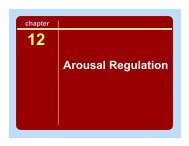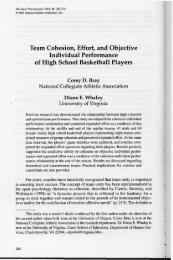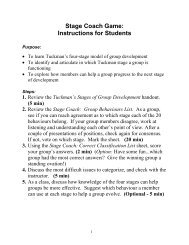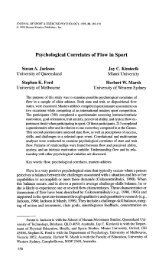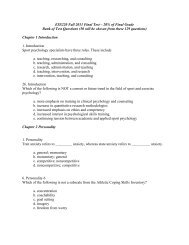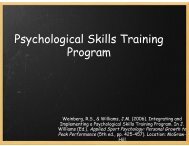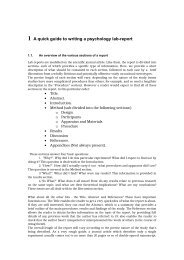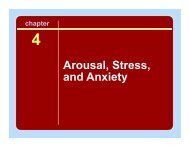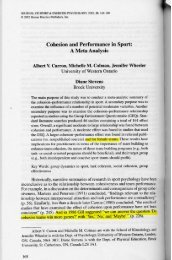Sport and Exercise Psychology Review - Sport Psychology Goes to ...
Sport and Exercise Psychology Review - Sport Psychology Goes to ...
Sport and Exercise Psychology Review - Sport Psychology Goes to ...
Create successful ePaper yourself
Turn your PDF publications into a flip-book with our unique Google optimized e-Paper software.
Jeffrey J. Martin<br />
Self-esteem, self-determinism <strong>and</strong> self-awareness<br />
are not typically viewed as directly<br />
impacting on performance. However, when<br />
viewing performance enhancement from a<br />
personal development model they are<br />
important considerations. <strong>Sport</strong> psychologists<br />
may clearly benefit their clients by being<br />
sensitive <strong>to</strong> the development of such personal<br />
qualities.<br />
Psychological skills <strong>and</strong> methods<br />
Researchers have suggested that athletes with<br />
disabilities use psychological skills (Martin &<br />
Mushett, 1997), would like <strong>to</strong> learn about psychological<br />
skills (Kirkby, 1995), mentally prepare<br />
for competition (Watanabe et al., 1992)<br />
<strong>and</strong> have favorable attitudes <strong>to</strong>wards sport<br />
psychologists (Page et al., 2001). As Hanrahan<br />
(in press) urges, sport psychologists<br />
should help athletes learn <strong>to</strong> ‘be in control of<br />
their own mental preparation’.<br />
Unique challenges<br />
Optimal levels of confidence <strong>and</strong> anxiety,<br />
<strong>and</strong> a clear task oriented focus promote<br />
superior performance (Morris & Thomas,<br />
2004). However, sport can be an anxious<br />
experience <strong>and</strong> athletes with disabilities face<br />
unique stressors. Campbell <strong>and</strong> Jones (2002a)<br />
for instance found elite wheelchair athletes<br />
experienced stressors such as pressures sores<br />
<strong>and</strong> the financial costs of their wheelchairs.<br />
Athletes with CP can have abnormal reflex<br />
activity during competition (Sherrill, 1998).<br />
Reliance on equipment (e.g wheelchairs),<br />
other people (e.g transportation needs) <strong>and</strong><br />
medication also present unique challenges.<br />
For example, wheelchair athletes have <strong>to</strong><br />
contend with poor road surfaces that impair<br />
performance <strong>and</strong> pose safety threats (Dattilo<br />
& Guadagnolo, 1988). Awareness of these<br />
challenges by sport psychologists can aid in<br />
helping athletes develop coping responses in<br />
preparation for difficulties.<br />
Goal Setting<br />
Athletes with disabilities can benefit from<br />
setting appropriate goals, <strong>and</strong> adherence <strong>to</strong><br />
effective goal setting principles is recommended.<br />
Watanabe et al. (1992) reported<br />
that although athletes with disabilities used<br />
mental preparation, they could benefit from<br />
setting goals for training, competition, <strong>and</strong><br />
dietary behaviours. Hedrick <strong>and</strong> Morse<br />
(1991) discussed goal setting practices for<br />
wheelchair basketball <strong>and</strong> provided a<br />
detailed feedback chart for offensive <strong>and</strong><br />
defensive goals.<br />
Imagery<br />
Recent research with athletes with visual<br />
impairments indicates that imagery is useful<br />
for motivational <strong>and</strong> cognitive reasons (Eddy<br />
& Mellalieu, 2003). However, we still know<br />
little about imagery use. Hanrahan (1998,<br />
2004) offers many useful suggestions. Athletes<br />
imaging missing limbs may get frustrated<br />
(Hanrahan, 1998) particularly if, for<br />
instance, an amputee images with the full<br />
use of all of his/her body parts (Hanrahan,<br />
in press). Surburg (1989) suggested that<br />
visuomo<strong>to</strong>r behaviour rehearsal (VMBR)<br />
might be a good technique for athletes with<br />
CP because relaxation may reduce spasticity<br />
which could disrupt imagery. Imagery<br />
should focus on developing a plan for goal<br />
attainment <strong>and</strong>/or a plan for resolution of<br />
stressful events as opposed <strong>to</strong> simply imaging<br />
a successful outcome (Taylor et al., 1998).<br />
Finally, depending on whether athletes<br />
became blind later in life or early in life, they<br />
may use different visual <strong>and</strong> spatial strategies<br />
in their imagery (Vanlierde & Wanet-<br />
Defalque, 2004). However, despite differences<br />
in imagery strategy, likely due <strong>to</strong><br />
differences in visual experience, both later<br />
<strong>and</strong> early life blind participants have been<br />
found <strong>to</strong> peform equally well <strong>to</strong> sighted<br />
participants (Vanlierde & Wanet-Defalque,<br />
2004).<br />
Self-talk<br />
Self-talk can be used for arousal moderation,<br />
technical proficiency, <strong>and</strong> the elimination/<br />
moderation of negative affect. First, self-talk<br />
may help athletes with disabilities moderate<br />
their arousal as, unlike physiologically based<br />
techniques, they may have more control over<br />
34 <strong>Sport</strong> & <strong>Exercise</strong> <strong>Psychology</strong> <strong>Review</strong> Vol 1 No 2



